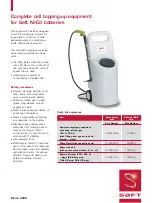
Page 3
Double insulated tools can use either a two or three wire extension cord.
As the distance from the supply outlet increases, you must use a heavier
gauge extension cord. Using extension cords with inadequately sized wire
causes a serious drop in voltage, resulting in loss of power and possible
tool damage. Refer to the table shown to determine the required minimum
wire size.
The smaller the gauge number of the wire, the greater the capacity of the
cord. For example, a 14 gauge cord can carry a higher current than a 16
gauge cord. When using more than one extension cord to make up the total
length, be sure each cord contains at least the minimum wire size required.
If you are using one extension cord for more than one tool, add the nameplate
amperes and use the sum to determine the required minimum wire size.
9.
DO NOT BURN, MUTILATE OR DISASSEMBLE BATTERY PACK.
The
battery pack can explode in a fire. Mutilation may expose battery
fluids, causing burns.
10.
BATTERY FLUIDS CAUSE SERIOUS CHEMICAL BURNS.
Never al-
low contact with skin or eyes. If a damaged battery pack leaks battery
fluids, use rubber or neoprene gloves to dispose of it. If skin is ex-
posed to battery fluids, wash with soap and water and rinse with
vinegar. Remove and dispose of contaminated clothing. If eyes are
affected, immediately flush with water for 15 minutes and seek medi-
cal attention.
11.
DO NOT SHORT CIRCUIT.
A battery pack will short circuit if a metal
object makes a connection between the positive and negative con-
tacts on the battery pack. Do not place a battery pack near anything
that may cause a short circuit, such as coins or keys in your pocket.
A short circuited battery pack may cause fire and personal injury.
12.
UNPLUG CHARGER
when not in use.
13.
TO REDUCE THE RISK OF ELECTRIC SHOCK
, always unplug charger
before cleaning or maintenance, turning off controls will not reduce
this risk. Use a Ground Fault Circuit Interrupter (GFCI) to reduce shock
hazards.
14.
STORE YOUR BATTERY PACK AND CHARGER
in a cool, dry place.
Do not store battery pack where temperatures may exceed 120°F
(50°C) such as in a vehicle or metal building during the summer. Charger
will charge
the battery when the temperature is between 41°F (5°C)
and 113°F (45°C). When the battery temperature is outside that range,
charging will not occur.
IMPORTANT SAFETY INSTRUCTIONS
SAVE THESE INSTRUCTIONS
1.
CAUTION!
To reduce the risk of injury, charge only
MILWAUKEE
12,
14.4 and 18 Volt battery packs in this charger. Other types of batteries
may explode, causing personal injury or damage.
2.
AVOID DANGEROUS ENVIRONMENTS.
Do not use charger in rain,
snow, damp or wet locations. Do not use battery pack or charger in
the presence of explosive atmospheres (gaseous fumes, dust or
flammable materials) because sparks may be generated when insert-
ing or removing battery pack, possibly causing fire.
3.
CHARGE IN A WELL VENTILATED AREA.
Do not block charger vents.
Keep them clear to allow proper ventilation. Do not allow smoking or
open flames near a charging battery pack. Vented gases may ex-
plode.
4.
MAINTAIN CHARGER CORD.
When unplugging charger, pull plug
rather than cord to reduce the risk of damage to the electrical plug and
cord. Never carry charger by its cord. Keep cord from heat, oil and
sharp edges. Make sure cord will not be stepped on, tripped over or
subjected to damage or stress. Do not use charger with damaged
cord or plug. Have a damaged cord replaced immediately with identi-
cal replacement parts (see Maintenance).
5.
DO NOT USE CHARGER OR BATTERY PACK IF
it has received a
sharp blow, been dropped or damaged in any way. Do not disas-
semble. Incorrect reassembly may result in the risk of electric shock,
fire or exposure to battery fluids. If it is damaged, take it to a
MILWAUKEE
service facility.
This manual contains important safety and operating instructions for battery chargers. Before using the battery charger, read this manual as well as any
labels on the charger, battery pack and tool.
7.
USE ONLY RECOMMENDED ATTACHMENTS.
Use of an attachment
not recommended or sold by the battery charger manufacturer may
result in a risk of fire, electric shock or personal injury.
8.
DO NOT USE AN EXTENSION CORD UNLESS IT IS ABSOLUTELY
NECESSARY.
Using the wrong, damaged or improperly wired exten-
sion cord could result in the risk of fire and electrical shock. If an
extension cord must be used:
If you are using an extension cord outdoors, be sure it is marked with
the suffix W-A (W in Canada) to indicate that it is acceptable for
outdoor use.
Be sure your extension cord is properly wired and in good electrical
condition. Always replace a damaged extension cord or have it re-
paired by a qualified person before using it.
Protect your extension cords from sharp objects, excessive heat and
damp or wet areas.
Unplug all cords during lightning storms or when unused for long
periods of time.
6.
CHARGER IS RATED FOR 120 VOLT
AC ONLY.
Charger must be plugged
into an appropriate receptacle, shown
in Figures A and B.
Fig. A
Fig. B
Nameplate
Amperes
0 - 5 **
5.1 - 8
8.1 - 12
12.1 - 15
15.1 - 20
Extension Cord Length
25'
16
16
14
12
10
75'
16
14
12
10
10
100'
14
12
10
10
--
150'
12
10
--
--
--
200'
12
--
--
--
--
Recommended Minimum Wire Gauge
for Extension Cords*
* Based on limiting the line voltage drop to five volts at
150% of the rated amperes.
** Indicates amps and cord gauge for Multi-Bay Charger.
50'
16
16
14
12
10
READ AND SAVE ALL INSTRUCTIONS FOR
FUTURE REFERENCE.
Summary of Contents for 48-59-0260
Page 2: ...Page 2 ...
Page 15: ...Page 15 ...


































